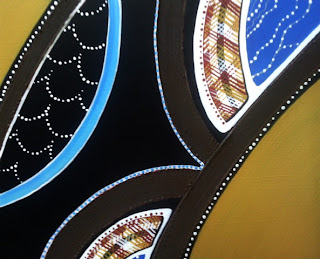I went into Tandanya Gallery on Grenfel Street a couple of weekends ago on the 31st of July, to get some ideas of what I would like to write about for my reflective paper/review, and see what Indigenous Australian artwork they had exhibited.The first exhibition I walked into was 'Believe' by Peter Sharrock, and I immediately liked the look of his work, as it was very not of what I had expected to see, and really took my mind out of what people stereotype Indigenous Australian artwork to look like. Sharrock's body of work had used a variety of mediums, from thick card to ceramics and focused very much on line, texture, shadow and tone. Many of Sharrock's works that were propped up on the walls stood out from its background and so when the lighting hit onto the carved out card, it created these lovely shadows which I feel gave the pieces of work a lot of body and interest to them. Something I really quite liked about Sharrock's work was that beside each was a poem that described the meaning of the work and what it was about, his works of art capturing moments from the everyday life.
Although many of Peter Sharrock's works were done around in the same manner, I found each had its own uniqueness and its own story to tell, and you can tell that many of his works would go back to his cultural heritage and relate to everyday urban life and issues. I think there's definitely a provoking essence to Sharrock's artwork, and they make you think about your life and your everyday issues and your identity.
A piece i quite liked from this exhibition of Peter Sharrock's was his piece titled 'The Mark'.
Mixed Media, 80 x 80 x11
It was the very first piece of work which you see as you walk into Peter Sharrock's 'Believe' exhibition, and I found it so encapsulating and different and was it the piece of work that immediately changed my views on Indigenous Australian artwork.
Another exhibition that was being held at the same time within the Tandanya Gallery was 'Eleven' by Christopher Crebbin. I too thought this exhibition was fascinating and had many beautiful and strong pieces of art which were also unlike any Indigenous Australian art i had seen. There were so many different layers to his works as well textures that were built up on the canvas, giving them depth and different characteristics, looking at Crebbin's artwork from different angles also revealed hidden elements that depended on how the light hit the painting. Crebbin paints under his Aboriginal name Burthurmarr, which means Brolga and native companion which i think is very touching, and you can see the connections made in his work to his heritage, family and the environment that is around him. I like that Crebbin too had next to his works something written about them and how this and the paintings told his stories, his protests and explored events in his life.
I think there was a very significant impact made on me with his work, and being able to talk with the artist himself was a great pleasure, to be able to hear from him personally what his work meant to him and how he saw his work, and his culture within that work.
These are just a couple of the artworks done by Christopher Crebbin that were in his exhibition 'Eleven'.
Moon
Yellow Serpent


